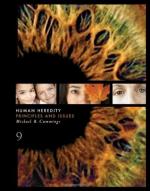|
This section contains 1,168 words (approx. 4 pages at 300 words per page) |

|
All living things pass on traits from one generation to the next according to a systematic set of "blueprints." These blueprints are contained in the long, thread-like chromosomes that lie inside the cell nucleus of all living things. On these chromosomes are genes that determine the hereditary traits of the offspring.
Egg and sperm cells, or sex cells, are specially formed to carry only one set of the 23 different chromosomes that are normally found in the human body. (Regular body cells have two sets of the 23 chromosomes.) When a mother's egg is fertilized by the father's sperm, the egg inherits one set of chromosomes from each parent, for a total of 46 chromosomes.
Some characteristics can only be inherited through genes and chromosomes: blood type, eye color, maleness or femaleness, etc. These are called hereditary traits. Most characteristics, however, are a result of both heredity and environment. For instance...
|
This section contains 1,168 words (approx. 4 pages at 300 words per page) |

|


